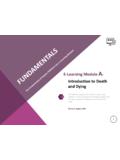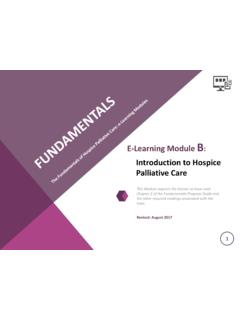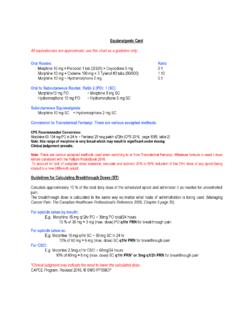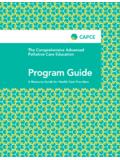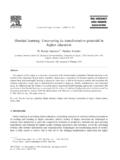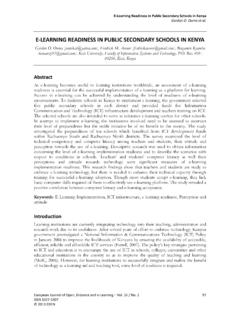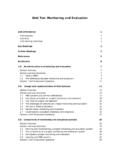Transcription of E-Learning Module Introduction to CAPCE and the …
1 E-Learning Module A: Introduction to CAPCE and the Nurse s Role in hospice palliative CareThis Module requires the learner to have read chapter 1 and 2 of the CAPCE Program Guide and the other required readings associated with the topic. See the CAPCE Program Guide required and recommended reading list for more : January 20171 Contents of this E-Learning Module may be reproduced in whole or in part provided the intended use is for non-commercial purposes and full acknowledgement is given to the Southwestern Ontario hospice palliative care Education Program and St. Joseph s Health care reference as follows: Southwestern Ontario hospice palliative care Education Program. Comprehensive Advanced palliative care Education E-Learning Modules.
2 London: Southwestern Ontario hospice palliative care Education Program, St. Joseph s Health care London; 2013; second edition STARTEDThis E-Learning Module has been designed to consolidate key concepts from the required readings and provide an opportunity to begin applying these concepts through self-directed reflection and scenario-based work, in preparation for the case-based discussions, in-person, with other STARTEDIn this Module , you will review the content highlights associated with the CAPCE program, and the Nurse s Role in hospice palliative may be asked to write down your thoughts or ideas during this Module . You can do so in the Notes section at the end of Chapter 1 and 2 in your Program Guide.
3 Have your Program Guide with you as you complete this notes are just for you; you won t be required to submit them. However, you may be prompted to use your notes for discussion in your Peer-to-Peer Exchange and Coaching Sessions. Please be respectful of COVERED Introduction to CAPCE : Critical Concepts CAPCE Performance Objectives Leadership Nurses Role in hospice palliative care The National Model to Guide hospice palliative care Foundational concepts of hospice palliative care Effective Communication Effective Group Function Ability to Facilitate Change 5 TOPICS COVERED Foundational Concepts of hospice palliative care Therapeutic Relationships Therapeutic Use of Self Phases of Therapeutic Relationships Self-Care6 Introduction TO CAPCE : CRITICAL CONCEPTSKey concepts associated with Introduction to CAPCE include.
4 Personal learning goals will help you measure your progress throughout the program and ensure this experience meets your unique needs The palliative care Nurse is an advocate, a change agent, and a nurse skilled in, not only the science, but the art of hospice palliative care The National Model to Guide HPC is the framework for the CAPCE program and enables nurses to identify issues faced by the person and family, provide palliative care based on best practice guidelines, and effectively assess and document outcomes. Building, maintaining and ending therapeutic relationships is central to the practice of a PERFORMANCE OBJECTIVESB ecoming a resource in HPC is much more than successfully completing the CAPCE course.
5 As a resource, you must be committed to continually developing your knowledge and skills in both the art and science of hospice palliative care . Review the performance objectives for the CAPCE program in your Program Guide. As you review them, reflect on where you currently are in your practice and how that compares to the CAPCE objectives. What gaps or learning opportunities do you see for yourself?Write your observations down in the Notes section following Chapter 1 in your program to the College of Nurses of Ontario, leadership is one of the seven professional standards. It is defined as: a relational process in which an individual seeks to influence others toward a mutually desirable goal (RNAO, 2006)Nurses emerge as leaders when they: Role model professional values, beliefs and attributes Provide coaching and mentoring to novice nurses Advocate for the person and family Collaborate with the health care team Develop therapeutic relationships with persons and families9 LEADERSHIPT hink about a colleague who, in your opinion, has embodied the definition of leadership.
6 What characteristics or qualities did or does that person possess? How did he or she influence you?10A NURSE IN hospice palliative CAREAs a nurse, you will accompany the person and family, providing support and care , throughout the illness trajectory. You will collaborate with members of the health care team and help coordinate care for the person and family members. When fully present in the illness journey, you will be able to engage in therapeutic encounters that, over time, build therapeutic relationships based on mutual trust. 11A NURSE IN hospice palliative CAREThe Nurse in palliative with the person and his or her family and other colleagues in problem solving and develops individualized care gaps in care delivery both at the bedside and within the strategies in response to identified gaps and organizational gaps and issues and possible problem solving strategies to management in an effort to enhance delivery of hospice palliative care within the for improved delivery of hospice palliative care within the organization.
7 12A NURSE IN hospice palliative care Consider the role of the nurse in palliative care and your place of work. Think about your response to the following questions, and then write down your answers in the Notes section at the end of Chapter 1 in your program and example of how you have collaborated with a health care team to develop individualized plans of care for a person and his or her one specific way you can advocate for improved delivery of hospice palliative care within your NURSE IN hospice palliative CAREGoal setting is a powerful process for thinking about your ideal future, and for motivating yourself to turn your vision into reality. What are your personal goals related to becoming a nurse in hospice palliative care ?
8 Identify three specific goals for your self and write them in the Notes section following Chapter 1 in your program guide. Be prepared to share and explain these goals with your CAPCE Coach (coaching session one). 14 THE NATIONAL MODEL TO GUIDE hospice palliative CARED eveloped by the Canadian hospice palliative care Association (CHPCA) in 2002, following ten years of collaborative effort, the hope for this model of care was to change the understanding of hospice and palliative care from care of the dying towards care that aims to relieve the suffering and improve quality of life throughout the illness and bereavement experience. One tool contained within the Model is The Square of care .
9 Turn to theSquare of Carein the Model document now and review. The Model is a required reading for the program. See the reading list for how to access this resource if you haven t done so already. 15 THE NATIONAL MODEL TO GUIDE hospice palliative CAREWhen a carpenter sets about to solve a problem, build something new, or enhance an existing object, he or she uses a carpenter's Square of Careis a tool just like a carpenter s square. Every time an issue is identified, the nurse will work through the steps of the Therapeutic Encounter (discussed more fully in Module B: Assessment).The steps of the Therapeutic Encounter will be familiar to you because they closely resemble the steps of a Nursing CONCEPTS OF hospice palliative CAREA ccording to the Model, there are three foundational concepts of hospice palliative Group to Facilitate Change17 EFFECTIVE COMMUNICATIONE ffective communication within your organization, your team, as well as, with the person and family is a skill that takes time and be an effective communicator, you a common language with in verbal/non-verbal communication, active listening, and appropriate data from the team, person.
10 And family and education for the person and family that is appropriate to respond to their needBeing a skilled communicator means taking risks, making mistakes, and learning from each GROUP FUNCTIONE ffective group function is dependent on effective communication, as well as negotiation and member of the team must be willing to consider the viewpoints of others an work together to provide care for the person and family.[Teamwork is] that work which is done by a group of people who possess individual expertise, who are responsible for making individual decisions, who hold a common purpose, and who meet together to communicate, share and consolidate knowledge from which plans are made, future decisions are influenced, and actions determined.
